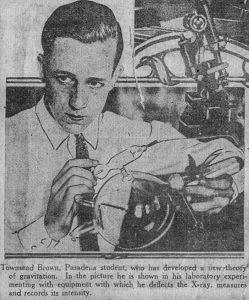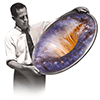This is Chapter 9 from The Man Who Mastered Gravity, now available from Amazon and fine booksellers everywhere.
(1924)

One invitee who did show up at Townsend Brown’s show-and-tell was a reporter for the Los Angeles Evening Express. Readers opening their paper on Monday, May 26, 1924, found a headline that read “Claims Gravity Is A Push, Not A Pull:”
Experiments now going on in a private laboratory at Pasadena by a youth of 18 may revolutionize the whole theory of gravitation as first deduced by Sir Isaac Newton.
Townsend Brown, a student of 706 Arden Road has conducted experiments since last September which have convinced him that while there is a law of gravitation, the force is caused by a ‘push’ and not by a ‘pull,’ and development of this theory by practical inventions will revolutionize industry.
Young Brown has his laboratory at home filled with expensive equipment to pursue his investigations. He is a normal, serious-minded young man with no false illusions about his mission in life, but with a desire to become a pioneer along the line of scientific research that will open the way for startling discoveries and inventions.
STATEMENT OF THEORY
In plain words, his theory is this: That ether waves from outside space push from all directions against the earth, and against other objects and planets in space, forcing objects the way the wave extends, instead of drawing them, according to the old Newton theory of gravitation.
By means of his equipment he conducts experiments with the X-ray, which is of the same family as light and the ether wave, and by means of which it is possible to test the theory. By means of this machine, he says, that since the X-ray is deflected, the gravity wave, being of the same family, also can be deflected.
REVOLUTIONARY
If this theory is proved so thoroughly that it displaces the Newton theory, inventions of the future will revolutionize human industry, according to the young scientist. By deflecting ether waves that are pushing against objects, man can control weight to such an extent that his deflecting machinery would enable him to lift a battleship out of the sea and set it on dry land.
After hitting the wire services, the story ran in the Zanesville, Ohio, Times Recorder, reminding local readers that…
Friends of the Brown family will remember that almost from infancy, Townsend has been interested in science and that he was the first person in Zanesville to have a radio, which he installed himself.
The story even made it into the pages of the New York Times, with a photograph of the “Pasadena student experimenting with equipment with which he deflects the X-ray” and showing Brown holding a Coolidge tube, at the time the most advanced – and expensive – device of its kind, which Townsend’s father purchased for his son. But it was not the ‘X-ray beams’ that Brown was curious about detecting. It was the tube itself – and how it behaved under high voltages.
The Coolidge tube was asymmetrical, built with a big difference in the size of the positive and negative electrodes. As Beau Kitselman wrote later,1 this difference inspired Brown’s experiments:
Brown mounted the Coolidge tube in a careful balance, as if it were an astronomical telescope. His idea was to point the tube in different directions and somehow find a variation in the power used by the tube, the strength of the X-rays generated, or something. He didn’t find what he was looking for, no matter where he aimed his apparatus, no tell-tale differences appeared. But he did find something he wasn’t looking for; he found that the X-ray tube generated a thrust, as if it wanted to move.
He soon learned that the new force was not produced by the X-rays, but by the high voltages which they required. Many experiments were necessary to make certain that the force was not one of the known effects of high voltage, and that it is a mass force, like gravity, rather than an area force, like most known electrical forces.
Kitselman said that these experiments with the Coolidge tube were the first indication that Townsend Brown had found a physical link between two elemental forces, electromagnetism and gravity – just as Einstein had predicted in theory.
The story in the Evening Express went so far as to speculate that “…control of gravitation might pave the way for a visit to Mars in a few years.” Though his ideas were being picked up on the wire services and printed as far away as New York, Brown was still felt the sting of rejection from classmates and faculty at Cal-Tech. At the end of his freshman year, he packed up all his gear and returned to Ohio. The following fall, he resumed his studies at Denison University in Granville, where he sought the counsel of the Professor of Astronomy, Dr. Paul Alfred Biefeld.
1 IBID Hello Stupid
